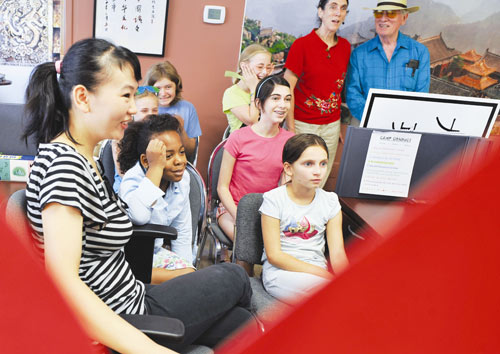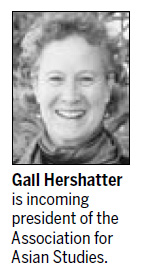Prime
Atop the new syllabus: Asia
Updated: 2011-03-31 10:39
By Kelly Chung Dawson (China Daily)
|
|
NEW YORK - The breadth of Asian studies in the United States is continuing to expand and become more integrated in many levels of education and experts say it has helped students gain a better understanding of the world.
"Education is fairly reactive," said Lynn Parisi, director of the Program for Teaching East Asia at the University of Colorado Boulder's Center for Asian Studies. "There's been a significant spike in (learning) Chinese in the last five years, and that's had a ripple effect on other parts of the curriculum. As the interest in Chinese language has gone up, so has the interest in strengthening the curriculum about China in other disciplines."
Asian studies, which slowly began gaining traction in the US in the early 1970s, often examines sociology and history to look into politics, culture and economics in Asia. Over the years the branch of studies has expanded into other disciplines and moved away from being merely a sidebar to Western perspectives.
|
|
The move away from teaching world history through a Western lens is a trend that has filtered down to lower levels of education in the US, as world history classes at the elementary and middle school levels have moved toward a higher dependence on source materials from China and other Asian countries, according to education experts.
"There has been a tendency to only bring Asia into the classroom when it has impacted the US," said Clayton Dube, associate director of the US-China Institute at the University of Southern California. "Students learn about Vietnam only in the context of the Vietnam War, rather than the history of that country itself. But that's changing, and the change is now being initiated from the bottom up. We see in secondary schools a real move toward world history and greater openness."
In California, middle school curriculums are now required to include sections on Confucius and philosopher Lao Tze, Dube said.
Geography, history, social studies and science now often include sections on the Asian perspective, said Roberta Martin, co-founder of National Consortium for Teaching about Asia (NCTA) and director of the Asia for Educators program at Columbia University's Weatherhead East Asian Institute.
"The curriculum doesn't privilege the West," Martin said.
This sensibility is also reflected in university courses, Dube said. "We're seeing an integration of Asian studies into other subjects," he said. "Now if you're studying sociology, not all of the examples are from Europe. You cannot study cinema without knowing something about Japanese cinema. You cannot study these subjects without knowing something about Asia, and that's the true triumph."
The Program for Teaching East Asia, for instance, is now based in seven outreach centers at universities around the US, said Parisi, who is also a co-founder of the NCTA. She said she has seen huge changes in the focus of Asian studies over the last 20 years.
One major push for the integration and expansion of Asian studies is at this year's Association for Asian Studies (AAS) conference, an annual meeting of scholars and experts in the subject.
Co-hosted by the International Convention of Asia Scholars, the conference will feature more than 750 panels between March 31 and April 3 in Honolulu, Hawaii. Organizers have placed a priority on including panels that originate in China, said incoming AAS President Gail Hershatter.
Panels at the conference have a number of focuses, such as Victorian interpretations of women in early 20th-century China, gay male elders in Hong Kong, Russia's relationship with Southeast Asia, and Buddhism in the age of the Internet.
"We've been working really hard to bring in scholars from Asia," Hershatter said. "We're aiming for a mixing of transnational perspectives. You don't just have American scholars talking with other American scholars - you find points of connection and places where ideas have traveled. "
Experts said the push to strengthen the curriculum about China in other disciplines has led to increased job opportunities for teachers. As the field of Asian studies continues to grow, the demand for university professors and competent Asian language experts has increased, Hershatter said.
"Every institution has woken up and realized that they cannot put together a curriculum that doesn't take account of Asia," she said. "They simply have to get past American and European history. The most important thing is that I don't feel like my students will have been properly educated unless they understand Asia, because it has profound effects on other regions of the world."
As a result, students generally enter college with a much higher working knowledge of Asia than in the past, she said.
This new expansion has meant a time of adjustment for teachers because they often come at Asian studies from a different angle or area of studies, said Anne Prescott, director of the Five College Center for East Asian Studies at Smith College.
"More and more studies across fields are conducted in Asia, or involve transnational collaborative teams, or take Asian sites as important places in which to understand major issues, like public health, urban planning and environment; and transnational effects in, for example, epidemiology and technology innovation," Hershatter said.
China Daily
Specials

Bin Laden dead
The world's most wanted man was killed in a US raid in Pakistan.

British Royal Wedding
Prince William and Kate Middleton married at Westminster Abbey in a royal occasion of dazzling pomp and pageantry.
Best wishes

The final frontier
Xinjiang is a mysterious land of extremes that never falls to fascinate.

